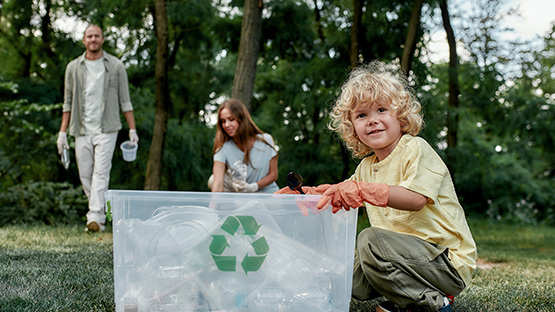Microplastics in cosmetics - how to recognise them?
Ekologia

21 January 2023
The problem of microplastics is growing every day. Harmful plastic particles not only affect the food industry, but also the cosmetics industry. How do you recognise it in body care products?
Microplastics in cosmetics - what are they?
Microplastics, as the name suggests, are micro plastic particles that do not exceed 5 mm in size. The smallest of these can be imperceptible to the human eye and can even reach dimensions of less than 1 µm (micrometre). There is a widely-held belief that the addition of microplastics in cosmetic formulations is not intentional and has to do with the pollution of soils and waters by this substance. Unfortunately, it turns out that this is not true and that manufacturers deliberately add raw material with plastic to their products.
But what use does microplastic have in cosmetics? First and foremost, it is a filler of sorts and a thickening, hardening and delaminating substance that appears velvety in texture. Many cosmetic companies, in order to reduce the price of care products, replace a naturally derived substance in the formulation with microplastic! Then, the ingredients that indicate the addition of such a substance are mainly: polymers, copolymers, polyethylenes, polypropylenes, PET and also polyamides. Some drugstore consumers, seeing the indication on the box that there is plastic in it, wonder whether microplastics in cosmetics are harmful.
Microplastics in cosmetics - are they a health hazard?
Research has proven that microplastics in cosmetic products are, contrary to appearances, neither toxic nor allergenic. The only inconvenience with prolonged use of cosmetics with microplastics may be the clogging of pores, which may consequently contribute to the formation of imperfections on the skin. However, it is important to remember that even though we ourselves do not feel the consequences from using products with ingredients with plastic additives, it does not mean that they are completely absent.
When applying any product to the face, sooner or later it is rinsed off with running water, which in turn enters the treatment plant and, in the last phase, flows into the treated effluent outlet. Unfortunately, most treatment plants are not designed to capture microplastic particles. As a result, microplastic ends up in the oceans, seas, rivers lakes and soils, being absorbed into food products. The items end up on shop shelves, from which consumers select products and then eat them. When humans eat microplastics, they damage cells. As a result, he or she may struggle with health problems such as cell death and allergies. 
Microplastics in cosmetics - how to recognise them?
Microplastics in cosmetics are usually indicated by the name of the synthetic material and numbers. Common indications that a plastic has been added to a product in a cosmetic include ingredients such as:
- polyacrylate crosspolymer-6 - a microplastic made of polyacrylate and cros polymer, marked as such, is responsible for the product's consistency. In addition, it is supposed to make it easier to spread the emulsion on the skin, as well as giving it a softer feel.
- polyquaternium-10 - a microplastic made from the chemical compound polyquaternium added to the contents to act as a regenerative agent for the hair and skin and to improve detangling, add shine and create a protective layer for the hair.
- polyacrylate-13 - a microplastic with polyacrylate in its composition, similar to polyacrylate crosspolymer-6, is designed to influence the concentration of the product, as well as to form a layer on the hair, nails and skin to counteract the release of water from the skin.
- acrylates copolymer - a microplastic acrylate copolymer, shown on the packaging under this name, is responsible for the viscosity, prevents the cosmetic from delaminating and extends the product's shelf life.
- sodium polyacrylate - the microplastic is made from sodium polyacrylate, which is responsible for the viscosity, extends the shelf life of the product and also protects against delamination.
Microplastics in cosmetics and ecology
Microplastics in cosmetics are unfortunately dangerous not only for humans, but for the entire ecosystem. The consequences of microplastic ingress are borne by the earth, water, plants, animals and also the air. As everything works in symbiosis, a chain reaction occurs. The soil soaks up the microplastic elements, which are passed on to the plants, which in turn are consumed by the animals. Meat, vegetables and fruit with plastic micronutrients end up in local shops, which are then sold to the consumer.
It is for these reasons that it is so important to buy natural cosmetics, which should be packaged using as little plastic as possible, for example in glass containers or bottles. In order to consciously buy safe cosmetics without added plastic, it is important to check the labels and raise awareness in relation to microplastics in creams and lotions, as well as other products.
In addition to this, it is important to be aware of the large companies that have the greatest impact on the environment. One company that cares about the environment is InPost. The company is not only distinguished by its fleet of electric cars, which do not emit harmful substances, but is also the originator and implementer of the Paczkomat® machine. The machine reduces carbon dioxide emissions by up to 75%, which has a significant impact on healthier air.
Microplastics - cosmetics to look out for
Plastic microbeads are increasingly found in cosmetic products from popular brands. Which products most often contain synthetic materials? Popular products containing microplastics include shower gels, conditioners, mascaras, oils, lipsticks, foundations, varnishes, toothpastes, shampoos, scrubs, make-up palettes and many others. Very often, substances such as polyethylene, nylon, methacrylate and polyethylene terephthalate are included in their formulation for better consistency and longer product life.
Czytaj również

Where to donate your clothes? Give them a second life together with InPost!
Where to donate clothes you no longer wear? Instead of throwing away good clothes, it is worth donating them to others for further use. Do...

Where to donate toys you no longer need? We have a good way to do it!
Quite a few children have rooms full of toys. They receive more gadgets from grandparents, parents or aunts and uncles. Sometimes the obje...




